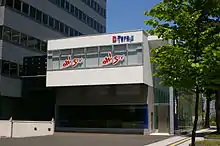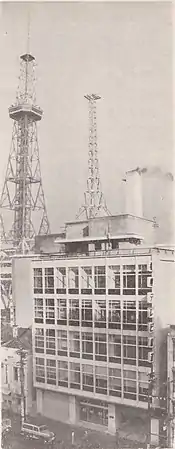Sapporo Television Broadcasting
Sapporo Television Broadcasting, Co., Ltd. (札幌テレビ放送株式会社, Sapporo Terebi Hōsō Kabushiki Gaisha) is a TV station of Nippon News Network (NNN) and Nippon Television Network System (NNS) in Hokkaidō, Japan. Headquartered in Sapporo, the capital city of Hokkaidō prefecture, the TV station was established on April 8, 1958. It is usually called "STV" for short, which is used as a name in a number of TV programs.
 | |
 | |
Native name | 札幌テレビ放送株式会社 |
|---|---|
Romanized name | Sapporo Terebi Hōsō kabushiki gaisha |
| Type | Private KK |
| Industry | information, communication |
| Founded | 8 April 1958 |
| Headquarters | 8-1-1, North-1-West, Chūō-ku, Sapporo , Japan |
Area served | Hokkaido Prefecture, Japan |
Key people | Toyoaki Negishi (President) |
| Services |
|
| Website | www |
| City | Sapporo |
|---|---|
| Channels | |
| Branding | STV |
| Programming | |
| Affiliations | Nippon Television Network System and Nippon News Network |
| Ownership | |
| Owner | Sapporo Television Broadcasting |
| History | |
| Founded | April 8, 1958 |
First air date | April 1, 1959 |
Former call signs | JOKX-TV |
Former channel number(s) | Analog: 5 (VHF, 1959-2011) |
| Fuji News Network (secondary; April 1, 1959 – March 31, 1972) | |
| Technical information | |
Licensing authority | MIC |
| ERP | 27 kW |
| Links | |
| Website | http://www.stv.jp/ |
| |
|---|---|
| Broadcast area | Hokkaido Prefecture |
| Frequency | 1440 kHz |
| Programming | |
| Format | Talk, Sports |
| Affiliations | NRN |
| Ownership | |
| Owner | Sapporo Television Broadcasting |
| History | |
First air date | December 15, 1962 |
| Technical information | |
| Power | 50,000 watts |
| Links | |
| Website | https://www.stv.jp/radio/index.html |

Since December 15, 1962, the company has worked as both television and radio station until July 12, 2005, when the radio section was split into the STV Radio Broadcasting, Co., Ltd. (STVラジオ株式会社, STV Rajio Kabushiki Gaisha) was established. Currently, the STV Radio is a radio station of National Radio Network (NRN) in Hokkaidō, Japan. The license of the radio broadcasting was succeeded to the STV Radio, and started radio broadcasting on October 1, 2005.
History
Early stages
In early 1957, Youzo Kurosawa (then president of the Hokkai Shimbun), Yoshjiro Kikuchi (then president of the Hokkaido Charcoal Steamship Company), and Yoshitaro Hagiwara (president of the Hokkaido Charcoal Steamship Company), considered the formation of a second private television station in Hokkaido.[1]: 9 Japan's national newspapers (Yomiuri Shimbun, Asahi Shimbun, Mainichi Shimbun, and Sankei Shimbun) attempted to enter the Hokkaido market at the time by combining two major sectors, television and newspapers, with the goal of creating a private television station.
This is unquestionably a serious danger to Hokkaido's native newspaper, the Hokkai Shimbun. Hokkai Shimbun and an unnamed Hokkaido firm sought for a commercial TV broadcasting license under the name "Sapporo TV" in April 1957.[1]: 9–10 And received their license on October of the same year.[1]: 11
Founding and early years

The company was founded on April 8, 1958.[1]: 11 STV began its TV broadcasts on April 1 the following year airing for at least 9 and a half hours a day. [1]: 20, 24 STV started as a dual affiliated station with NNN as their primary affiliate and FNN as their secondary affiliate.[1]: 24 The network also aired certain programming from Nippon Educational Television (currently TV Asahi) alongside HBC. Since Sapporo TV initially obtained a quasi-educational station license, the station had to follow educational quotas for a substantnial proportion of its programming.[1]: 24 Sapporo TV's first self-produced program is also an educational program "Television Fudoki".[1]: 25 In the first year of broadcasting, Sapporo TV's corporate income entered the top ten in Hokkaido.[1]: 25 In 1960, the Sapporo TV Broadcasting Hall was completed, enabling Sapporo TV to have its own TV studio.[1]: 29 In the same year, the Sapporo Television Union also announced its establishment.[1]: 29 In 1961, STV's turnover reached 1.27 billion yen, and the average monthly turnover exceeded 100 million yen.[1]: 34
Prior to its official TV broadcasts, STV also applied a radio broadcasting license in 1958 (which was later rejected).[1]: 17 The broadcaster applied for a license again on February 17, 1961 and was granted on July 10, 1962 becoming the only broadcaster in Japan to start TV broadcasts then radio broadcasts (STV Radio started broadcasting on December 15, 1962).[1]: 17 NET TV stopped providing programs to STV after it moved its remaining programs to HBC sometime in 1962.[1]: 29 Relying on the principle of thorough budget frugality, Sapporo TV set a very high profit rate of 42.5% in the second half of 1963.[1]: 18 In 1964, the station's signal had covered 95% of the population of Hokkaido.[1]: 46 On March 20, 1966, STV started to air programs in color.[1]: 57 STV joined NNN as one of its founding members on April 1, 1966, to strengthen the news reporting system.[1]: 56 When the TV broadcasting license was renewed in 1967, the broadcasting license of Sapporo TV Station was changed from a quasi-educational station to a general TV station, withdrawing the former quotas introduced upon launch. The programming was more free and more entertainment programs were braodcast.[1]: 62 Sapporo TV's program production ability also improved in the late 1960s, and in 1969, it assisted in the production of the popular late-night program 11PM[1]: 77 of the Nippon Television Network. In 1971, Sapporo TV Station built a new broadcasting hall, whose building area was three times that of the old broadcasting hall,[1]: 84 and set up a special studio for TV news.[1]: 87
In 1972, Sapporo TV also assisted in broadcasting the Sapporo Winter Olympics.[1]: 90–91 STV ended airing programs from Fuji TV/FNN after UHB started broadcasting on April 1, 1972.[1]: 91 Sapporo TV started was the first broadcaster to use the automatic advertising broadcast system.[1]: 114 In 1978, the 20th anniversary of the broadcast, Sapporo TV produced special programs such as the documentary "One Year", and held special events such as "European Famous Paintings Appreciation Conference".[1]: 118 In 1980, the turnover of Sapporo TV's television department reached 8.34 billion yen, and the revenue of the broadcasting department reached 1.736 billion yen.[1]: 139 In 1984, the turnover of Sapporo TV's TV department exceeded 10 billion yen, and the broadcasting department exceeded 2 billion yen.[1]: 157 In 1985, the listening rate of STV radio surpassed that of Hokkaido Broadcasting for the first time, and won the first place in Hokkaido.[1]: 156 In 1991, Sapporo TV's TV department had a turnover of 13.374 billion yen, and its broadcasting department had a turnover of 3.21 billion yen, becoming the private broadcasting company with the highest turnover in Hokkaido for the first time.[1]: 203 In 1993, to commemorate the 35th anniversary of the broadcast, Sapporo TV held the "Higashiyama Kaii" exhibition, which attracted 100,000 people to visit.[1]: 208 In the same year, Sapporo TV's average audience rating for the whole day was 10.4%, the average audience rating for prime time was 16%, and the average audience rating for evening time was 15.3%. The first time to win the ratings triple crown in the Hokkaido area.[1]: 209 In January 1996, Sapporo TV opened its official website.[1]: 224 In 1998, the 40th anniversary of broadcasting, Sapporo TV opened a Berlin branch to strengthen the collection of overseas news.[1]: 234 But in 2005, Sapporo TV closed the Berlin branch and opened the Moscow branch.[1]: 276
In 1993, STV ranked number 1 in TV ratings for the first time.[1]: 209 In 1998, the 40th anniversary of the network, the network opened its NNN bureau in Berlin[1]: 234 (later closed in 2005 and opened a news bureau in Moscow on the same year instead[1]: 276 ).
2000s
On April 7, 2000, the Sapporo Media Park "Spica" invested by the network officially opened, becoming an important cultural base in Sapporo.[1]: 250 However, due to continued losses, STV withdrew from operating Spica in 2007 (parts of the Spica building was later demolished by the following year) .[1]: 286–287 Since 2003, STV was number 1 in TV ratings.[1]: 271 On July 13, 2005, STV separated its radio operations into a wholly owned subsidiary, STV Radio.[1]: 280
On June 1, 2006, STV started digital broadcasting[1]: 281–282 (which expanded its digital relay stations in its sub-prefectures by the following year.[1]: 288 However, due to the increase in investment in digital TV equipment, Sapporo TV suffered a loss for the first time since its broadcast in 2006.[1]: 288 Analog broadcasting then ended on July 24, 2011.[2] As of 2019, STV has been number 1 in TV ratings for 12 years, with its all-day ratings also number 1 for 27 years since 1993 continuing to set the longest record in Japan.[3]
Technical Information
| Sub-prefecture | TV | Radio | ||
|---|---|---|---|---|
| Analog | Digital | AM | FM | |
| Sapporo[lower-roman 1] | JOKX-TV; 5ch | JOKX-DTV; 5ch | JOWF; 1440kHz | 90.4MHz |
| Muroran[lower-roman 2] | JOLY-TV; 7ch | |||
| Hakodate[lower-roman 3] | JOMY-TV; 12ch | |||
| Asahikawa[lower-roman 4] | JOKY-TV; 7ch | JOWL; 1197kHz | ||
| Obihiro[lower-roman 5] | JOWL-TV; 10ch | JOWM; 1071kHz | ||
| Kushiro[lower-roman 6] | JOSY-TV; 7ch | JOWS; 882kHz JOXS; 1062kHz (Nemuro) | ||
| Kitami - Abashiri[lower-roman 7] | JOYS-TV; 7ch | JOYS; 1485kHz | ||
Programs
STV
- Dosanko Wide
- Dosanko Sunday
- Bakushou Mondai no SUSUME
- ippachi ikouyo!
STV Radio
- OHAYO!! HOKKAIDO
- Attack Young(end)
- AtaYoun PUSH!
- Weekend Variety Goro-Hidaka Show (every Saturday)
- All Night Nippon (from Nippon Broadcasting System, Incorporated (LF))
- All Night Nippon (Mon. - Sat. 25:00 - 27:00)
- All Night Nippon Ever Green (Mon. - Thu. 27:00 - 29:00)
- All Night Nippon R (Fri. 27:00 - 29:00, Sat. 27:00 - 28:30)
- All Night Nippon Record (Sat. 28:30 - 29:00, not including LF)
Rival
References
- Includes the Ishikari Subprefecture, Shiribeshi Subprefecture, central and southern Sorachi Subprefecture
- Includes the Iburi Subprefecture and Hidaka Subprefecture
- Includes the Oshima Subprefecture and Hiyama Subprefecture
- Includes the Kamikawa Subprefecture, northern Sorachi Subprefecture, Rumoi Subprefecture and Sōya Subprefecture
- Includes the Tokachi Subprefecture
- Includes the Kushiro Subprefecture and Nemuro Subprefecture
- Includes the Abashiri Subprefecture
- 札幌テレビ放送50年の步み [50 Years of Sapporo Television Broadcasting] (in Japanese). Sapporo Television Broadcasting. 2008. OCLC 422697737.
- "『地デジ』完全移行まで「あと100日」です。" [100 Days until the complete transition of digital Broadcasting in Hokkaido]. Ministry Of Internal Affairs and Communications (in Japanese). 2011-04-15. Archived from the original on 2013-03-09. Retrieved 2021-07-19.
- "2019年『年間』視聴率、STVが12年連続3冠達成!" [STV wins the triple crown for the 12th year in a row]. Sapporo Television Broadcasting (in Japanese). 2020-08-25. Archived from the original on 2020-08-25. Retrieved 2021-07-19.